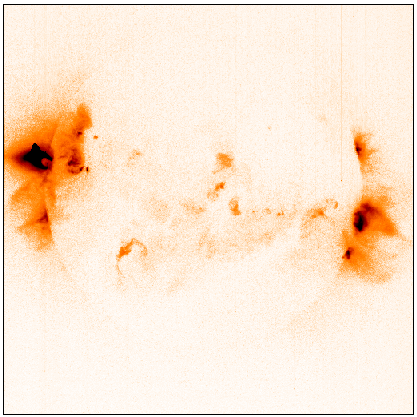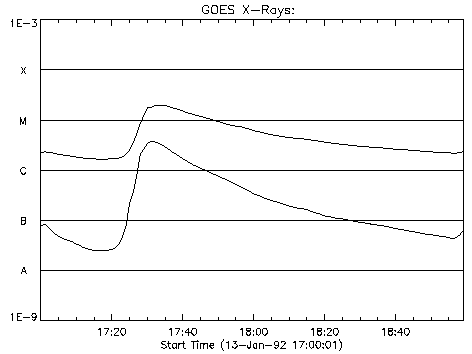Can you see a part which has lots of X-rays (remember this is a reverse colour image of the Sun)?
Image copyright Yohkoh Data Archive Centre, MSSL, Department Space and Climate Physics, UCL.

Solar flares are the biggest explosions in our solar system. We see a sudden and huge increase in brightness on the Sun. The increase isn't just in white light, but in the ultraviolet, X-rays, gamma-rays, and radio waves as well.
|
Have a look at the image above - it's an X-ray picture of the Sun
in reverse colour. Normally when we look at images of the Sun
then we colour those bits of the Sun with more X-rays brighter
than those with less X-rays. Sometimes, though, it is easier to see
what is going on on the Sun if you colour those bits of the Sun with
more X-rays darker than those with less X-rays (which,
consequently look brighter). When we do this then we say the image is
in reverse colour.
Can you see a part which has lots of X-rays (remember this is a reverse colour image of the Sun)? Image copyright Yohkoh Data Archive Centre, MSSL, Department Space and Climate Physics, UCL. |

|
When a flare goes off, the temperature can get up to and even above 10 million degrees.

|
Here is a plot of X-ray brightness for two flares observed by a satellite
called GOES (Geosynchronous Operational Environmental Satellite).
Each of the horizontal lines indicates a level of X-rays 10 times as
high the line directly beneath it. Therefore the scale on
the y-axis shows us by how much the brightness has increased by
factors of 10. We use letters to tell us how big the flare is. This
flare was an M-class flare because its brightness went past the M level.
Really big ones are X-class
flares. | |
The first solar flare was seen in 1851, when astronomers were looking at sunspots in visible light. Of course this wasn't the first flare on the Sun, just the first one that we'd been able to see! Two astronomers, Carringtion and Hodgeson, happened to be observing the Sun independently at the time - they were lucky that the flare they saw was a large one and clearly observable in visible light!

|